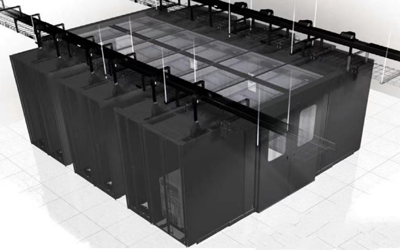In the early construction of large computer rooms and data centers, almost all computer rooms had raised floors.
The raised space under the floor is a crucial channel for airflow distribution. Cooling equipment directs cold air into the raised floor, ensuring an even distribution of cold air to the racks in the equipment room. Additionally, data cables and power lines can also be placed in the raised floor space.

Raised Floor
In recent years, more and more data centers are opting for flat floor installations, elevating cooling channels and power cables above the racks

The diagram above illustrates an environment with a raised floor, where CRAC/CRAH units, along with power and network infrastructure, are seamlessly integrated beneath the floor. In this setup, cool air rises from below the floor through vented panels placed in front of each cabinet or row of cabinets to achieve cooling. Raised floors typically don’t require significant depth. However, if the vented panels are too close to the cooling units, they may create a “Chimney Effect,” generating low-pressure adhesion and compromising the cooling efficiency.
In most cases, raised floors typically do not require significant depth. However, if the vented panels are positioned too close to the cooling units, these panels may generate a “Chimney Effect,” resulting in a low-pressure adhesion effect that can diminish the cooling efficiency.
Flat Flooring
Some data centers opt for concrete flooring, where the cooling system is positioned above the data center, employing a top-down cooling approach.
Limited research suggests that in high-density environments (exceeding 250 watts per square foot), flat flooring may provide more effective cooling to cabinets compared to raised floors

Flat flooring designs can be employed in all types of data storage facilities and server rooms. Currently, situations where the use of hard flooring is more suitable include:
-Super-sized data centers: Characterized by high density and large power requirements.
-High-density data centers: Can benefit from innovative air circulation systems and hot aisle containment strategies.
-In compact spaces: Where raising the floor is not feasible, making it challenging to achieve the desired power density.
Cold and Hot Aisle Containment
Despite the ongoing debate between raised floors and flat floors, there is no doubt that the most efficient way to deliver cooling to server cabinets is through some form of hot or cold aisle containment.
The enclosed cooling system in the data center constructs dedicated channels for CRAC or CRAH units, precisely cooling at the server level without introducing external heat.

Closed cold and hot aisle containment significantly reduces PUE because there is no inefficient space that is neither cooled nor heated. Consequently, data centers do not need to control additional environmental temperatures, focusing solely on precise rack temperature control.


Essentially, by reducing the volume of air that needs to be cooled, the cooling workload is significantly reduced, resulting in a lower PUE. Such a system, when optimized, allows the facility to provide higher power densities.
Economical Cooling on the Heat Dissipation End
The air-side cooling unit brings outdoor air into the building and distributes it to the data center floors. The air expelled by the servers is not recirculated and cooled but is instead directly expelled outside. This is also known as “external air cooling” or “ambient air cooling.”

This method usually works in conjunction with conventional coolers, bringing air from the outside of the building into the facility. Newer data centers, situated in regions where the average temperature remains between 18 to 27 degrees, tend to utilize ambient air to meet most of their cooling needs.
The primary goal of employing this cooling method is cost savings. If the outside air is exceptionally cold, the cooling unit can mix it with the expelled air, resulting in exhaust temperatures and humidity falling within the range required by the equipment.
The factors affecting cooling systems, such as data center air conditioning, raised floors, and hot/cold aisle containment, are closely integrated in practical applications. Therefore, choosing Tuxin-Data Center allows us to customize products based on specific requirements.
Tuxin main product:
Server rack
Network cabinets
Open racks
Wall mounted cabinets
PDU
Other communication equipment and accessories
You can click on this website to learn about related products:www.nbtuxin.com





